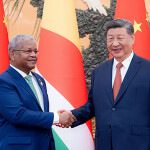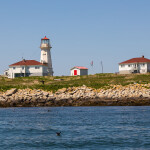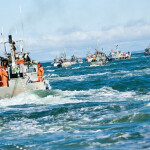While it’s fair to say that the year-long Russian import ban implemented six months ago by President Vladimir Putin has altered certain dynamics within Norway’s seafood industry, most sectors have been relatively unhurt by the collapse of the key trade avenue.
Russia’s ban came into force on 7 August 2014 and capped Norway’s seafood exports to the market at NOK 3.4 billion (EUR 393.3 million; USD 450.5 million) for the year, which was 48 percent less than achieved in 2013, according to figures published by the Norwegian Seafood Council (NSC). Fortunately, exporters were able to mitigate this loss by ramping up business with other markets. Most notably, the EU — the country’s No. 1 market — was willing to take on more, increasing its total exports by 16 percent to NOK 43 billion (EUR 5 billion; USD 5.7 billion).
Thanks in part to the change in trade patterns, Norway’s seafood exports achieved a record total of NOK 68.8 billion (EUR 8 billion; USD 9.1 billion) in 2014, 12 percent or NOK 7.3 billion (EUR 844.6 million; USD 967.3 million) more than in the year before and the previous record. Last year’s total also included record export values for cod, mackerel and farmed Atlantic salmon, its top-value product.
“Of course, the salmon trade was affected by the ban but the consequences were not big because the salmon exporters have many customers all over the world and they were able to manage themselves,” said Ingrid Dahl Skarstein, NSC’s director for Russia. “Exporters managed to turn the vehicles round that were on their way to the Russian border and put the products elsewhere.”
It would have been a bigger headache for the pelagic sector to find new clients as Russia is one of its main markets for herring, along with Ukraine and Poland, and it is such a “specific product,” which is difficult to build markets for, said Skarstein. However, it should be remembered that at the beginning of 2014, the Russian Federal Service for Veterinary and Phytosanitary Surveillance (Rosselkhoznadzor), imposed a boycott on Norway’s whitefish and pelagics, citing alleged unhygienic practices. This move, which did not include salmon or trout, affected several hundred Norwegian exporters and meant that the overall access to the market by those sectors was already limited.
Salmon shifts
Prior to the broader import ban, Russia historically accounted for between 9 and 10 percent of Norwegian salmon exports. While some of this was diverted to the Far East last year, the EU took the lion’s share and ended up accounting for around 75 percent of the trade, up from 65 percent in 2013.
“The increase to the EU has been huge,” said Skarstein. “Established markets like the United Kingdom and Portugal are taking much more than before.”
Furthermore, salmon volumes going into Russia in the opening seven months of 2014 were down year-on-year and this has been attributed to the high prices that prevailed last year.
While Skarstein believes it’s not accurate to label Russia as a price-sensitive market as it did still buy Norwegian salmon during periods with high prices and remained “an important trade,” the volumes imported would noticeably go down when prices were high and conversely go up when they were low.
In 2012, for example, the exports from Norway to Russia soared because the prices “were much more available to the Russians,” she said.
Global outlook
Despite Norwegian salmon not having access to the Russian market for a large chunk of last year, there was a strong increase in global demand, confirmed Paul Aandahl, the NSC’s branch manager for salmon.
“Last year, the increase in demand was almost as high as the average that we have seen for the last 12 years and we expect it to continue to grow in line with the forecasted small increase in production. That also means we can expect prices to stay at a high level both this year and also next year. We don’t expect any major increase in the global production of Atlantic salmon,” said Aandaal.
In theory, both demand and prices should grow once the Russian trade ban ends in August — assuming it sticks to the 12-month schedule, and there are no official indications that this won’t be the case.
“I am sure that when the ban ends, Russia will start to take Norwegian salmon again, which will represent more demand than when Russia was closed. But if the price of salmon is higher than now or the level that it was before the ban in 2014, it will have an impact on how much the Russians decide to take,” said Skarstein.
The Russian trade will also depend on the country’s economy, in particular its fast-weakening ruble, added Aandahl.
“With the lower buying power of Russia, we can also expect that its salmon imports from Chile and the Faroes will be lower, which will increase the competition from those products in other markets,” he said.






